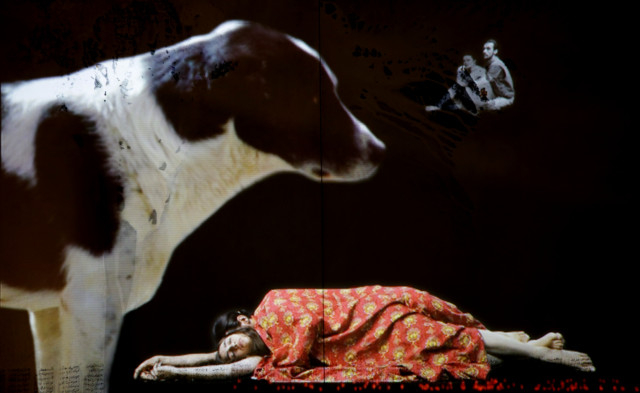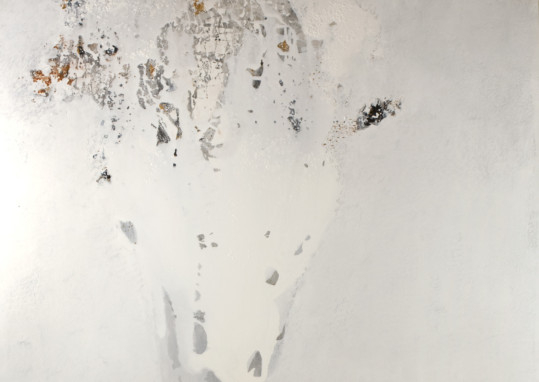
As a tribute to well-known Iranian artist Farideh Lashai, who passed away in February after a long battle with cancer, The Farjam Foundation (formerly The Farjam Collection) has organised a special exhibition that commemorates her life and work. The artworks in the show, titled “In Memory of Farideh Lashai (1944- 2013)”, are drawn from the foundation’s private collection, and include paintings from various periods in Lashai’s career stretching more than five decades as well as recent works that combine animation and video art with abstract paintings. The exhibition is a celebration of the unique lyrical visual vocabulary developed by one of Iran’s most prominent contemporary artists.
Lashai was born in Rasht, Iran, in 1944. She was a writer, sculptor, painter and installation and video artist, whose work captured the shifting political and cultural landscape of her homeland and voiced her feelings of nostalgia, loss and hope. Art and literature were her two big loves. She studied German literature at the University of Frankfurt, and her literary achievements include Farsi translations of German playwright Bertoldt Brecht’s works, and the critically acclaimed novel, “Shal Bamu” (The Jackal Came), published in 2003.
Lashai also had a bachelor’s degree in glass design from the Academy of Decorative Arts in Vienna, and began her artistic career as a crystal designer at Riedel Studios, Austria, and then at Studio Rosenthal in Germany. After returning to Iran in the late 1960s she focused on painting and developed her unique style that combined classical and modern European artistic traditions with imagery drawn from traditional Iranian art. She is well known for her abstract landscapes, especially her paintings of trees, which, to her, symbolised life and eternity. The exhibition features many of these paintings, showcasing her ability to convey the beauty, serenity and mystery of the forest with a few deft strokes and minimal colours.
The artist was also known for fearlessly expressing in her work her views about Iran’s social and political situation, as well as her admiration for Mohammad Mossadegh, the Iranian leader who nationalised the country’s oil companies. The show recognises this aspect of Lashai’s work through a 2009 portrait of Mossadegh and other paintings featuring his unmistakable silhouette.
Throughout her decade-long battle with cancer, Lashai’s passion for her work and for experimenting with new media remained undiminished. During this period she began working with animated video projections on her paintings to create a fantasy world where rabbits frolicked among the trees, birds flew in and out of the canvases and various characters appeared in the narrative. Describing her joy in these works, she said, “It is a blow of magic with which invisible creatures that had no shape or form appear from the depth of a mysterious, abstract scenery, full of life and charged with untold narratives, expanding the painting as an elastic structure in time, material and space, then disappear, leaving behind a silent still painting, yet now charged with the mythical, the imagined and creating colossal spaces for fantasies.”
The show features two significant works from this period. The first, titled “El Amal”, was created in 2011, at the height of the Arab Spring protests in Egypt. It combines images of Charlie Chaplin from his film “The Great Dictator” and of legendary Egyptian singer Umm Kalthoum. Her face appears on the top of the painting, but her eyes are closed as if ignoring the dictator dancing excitedly to the tune of her song “El Amal”, which means “hope” or “desire”. The dictator is shown playing with the globe and bouncing it around, indicating his desire to possess the world. But at the end of the song, the globe bursts leaving him empty-handed, and the majestic face of Kalthoum calmly fades away. The work has strong political undertones, but it is essentially about the power and immortality of art and its role in defining and preserving the identity of a nation.
The other work, titled “I Don’t Want to be a Tree; I Want to be its Meaning”, is from 2008. It is inspired by Turkish writer Orhan Pamuk’s tale of a tree that is destined to enter the pages of a great manuscript in the late 16th century, but is lost and left as a solitary image. Through three simultaneous video projections on three sets of paintings, Lashai presents various imaginary scenarios in which the tree could have featured. The animated, photographic images in the videos include a storyteller; characters from folk tales; the ill fated lovers Laila and Majnu; figures from a controversial Manet painting; a dog and the text from Pamuk’s story. The figures can be seen lying under the tree in her paintings or hiding behind it. They move and morph into one another, metamorphosing from Western figures to Oriental ones, from nude figures to conservatively dressed ones, and from 19th-century characters to contemporary ones. This complex, layered work contemplates the nature of artistic depiction, the contrast between appearance and essence, the relationship between objects and their environment, and the perception and role of art in different societies. It is an excellent example of Lashai’s gift for presenting profound concepts with humour and playfulness.
“Throughout her life, Farideh’s powerful imagination and innate artistic genius combined to create artworks that inspire us to contemplate the very nature of the human condition, our beliefs, our sense of self and of belonging. By constantly challenging herself to push the boundaries of her artistic expression, she inspired us all to challenge convention, question our limitations, and combat inequality. Her character and her art have left a deep and enduring imprint, and her legacy will live on. This retrospective commemorates her life and bears witness to the magnitude of her achievements,” Dr Farhad Farjam says.
Jyoti Kalsi is an arts enthusiast based in Dubai.
The show will run at The Farjam Foundation, DIFC, until June 18.
Box: ‘We are all like the rabbit’
Lashai’s last solo exhibition in Dubai was in 2010. Titled “Rabbit In Wonderland”, it featured a series of animated video paintings filled with real and fictional characters. As always, the work was personal and about her country but had universal resonance. Commenting on this allegorical and highly political body of work, the artist told Weekend Review, “I chose the rabbit as my central character because it is inquisitive, full of energy and so beautiful. His desire to be independent, his attraction towards new ideologies, his disillusionment, his vulnerability and his confusion certainly reflect my own inner journey. But this is not just my story. Most of us have been through a similar journey. We are all like the rabbit — lost and helpless in the hands of systems, ideologies and prejudice, unable to discern right from wrong, oscillating between hope and despair and looking for answers. Like Alice in wonderland, we are caught in a crazy world that seems to be upside down and are desperately trying to make sense of it.”





